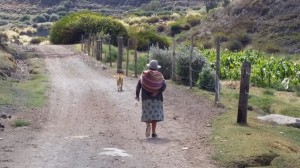 Abbiamo deciso di andare a Putre che si trova nell'entroterra vicino ad Arica, verso il confine con la Bolivia; vogliamo vedere i vulcani Parinacota e Pomerape e il lago Chungara tutto oltre i 4.000metri di altitudine. Putre sta a 3.500 metri ed e' un posto perfetto per acclimatarsi all'altitudine.
Da Arica non e' distante, solamente 3-4 ore di bus anzi dovrei dire di corriera, ma inziamo dall'inizio: la sveglia.
Dopo una notte insonne per la sottoscritta (ho avuto un attacco di verdurite acuta e ho viaggiato avanti-indietro al bagno tutta la notte), la sveglia anziche' suonare alle 5e40 per avere il tempo di finire la borsa, fare colazione e prendere un taxi per andare alla fermata del bus, e' suonata alle 6e40. Ooops errore! Quindi niente colazione e in 10 minuti netti abbiamo chiuso le borse, preso il taxi e siamo arrivati al bus 'La Paloma', che parte alle 7 tutte le mattine per andare a Putre, ed e' l'unico mezzo per andarci..... una corriera vecchio stile, mancavano solo le galline sul tetto!!
Alla fine arrivammo.
Abbiamo deciso di andare a Putre che si trova nell'entroterra vicino ad Arica, verso il confine con la Bolivia; vogliamo vedere i vulcani Parinacota e Pomerape e il lago Chungara tutto oltre i 4.000metri di altitudine. Putre sta a 3.500 metri ed e' un posto perfetto per acclimatarsi all'altitudine.
Da Arica non e' distante, solamente 3-4 ore di bus anzi dovrei dire di corriera, ma inziamo dall'inizio: la sveglia.
Dopo una notte insonne per la sottoscritta (ho avuto un attacco di verdurite acuta e ho viaggiato avanti-indietro al bagno tutta la notte), la sveglia anziche' suonare alle 5e40 per avere il tempo di finire la borsa, fare colazione e prendere un taxi per andare alla fermata del bus, e' suonata alle 6e40. Ooops errore! Quindi niente colazione e in 10 minuti netti abbiamo chiuso le borse, preso il taxi e siamo arrivati al bus 'La Paloma', che parte alle 7 tutte le mattine per andare a Putre, ed e' l'unico mezzo per andarci..... una corriera vecchio stile, mancavano solo le galline sul tetto!!
Alla fine arrivammo.
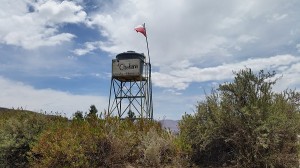 A Putre non c'e' nulla e visto che e' la stagione delle piogge piove tutti i pomeriggi; la conseguenza naturale e' che i servizi saltano e quindi non c'e' ne' acqua ne' elettricita'. Non ci perdiamo d'animo ed andiamo a posare gli zaini. Abbiamo prenotato due letti in dormitorio, a la Chakana, un ostello appena fuori il centro che ha tutte casette da due, tre, quattro o sei letti per gli ospiti con bagno. Carino se non fosse per i locali che lo gestiscono, i quali sono socievoli come dei cactus. Nonostate la difficolta' comunicativa riusciamo ad estorcere informazioni per le escursioni e una bella mappetta con didascalie tattiche.
Usciamo a fare un giro in compagnia di Kerrin, tedesca anche lei in viaggio per sei mesi nel Sud America. Era con noi all'ostello ad Arica, nel bus e ora e' diventata parte del nostro piccolo gruppo di escursioni. In poco tempo ci organizziamo per lunedi la passeggiata ai vulcani, lago e ci infiliamo anche le terme e decidiamo inoltre di fare una passeggiata l'indomani per vedere le pitture rupestri Wilacabrani.
A Putre non c'e' nulla e visto che e' la stagione delle piogge piove tutti i pomeriggi; la conseguenza naturale e' che i servizi saltano e quindi non c'e' ne' acqua ne' elettricita'. Non ci perdiamo d'animo ed andiamo a posare gli zaini. Abbiamo prenotato due letti in dormitorio, a la Chakana, un ostello appena fuori il centro che ha tutte casette da due, tre, quattro o sei letti per gli ospiti con bagno. Carino se non fosse per i locali che lo gestiscono, i quali sono socievoli come dei cactus. Nonostate la difficolta' comunicativa riusciamo ad estorcere informazioni per le escursioni e una bella mappetta con didascalie tattiche.
Usciamo a fare un giro in compagnia di Kerrin, tedesca anche lei in viaggio per sei mesi nel Sud America. Era con noi all'ostello ad Arica, nel bus e ora e' diventata parte del nostro piccolo gruppo di escursioni. In poco tempo ci organizziamo per lunedi la passeggiata ai vulcani, lago e ci infiliamo anche le terme e decidiamo inoltre di fare una passeggiata l'indomani per vedere le pitture rupestri Wilacabrani.
 Pictografias de Wilacabranu. Domenica 1 Feb.
Dopo una colazione abbondante a suon di cumbre gentilmente offerta dalla famiglia di cactus, abbiamo iniziamo il nostro trekking verso le pitture 'wila' (color rosso) 'cabrani' (lama) seconda la lingua Aymara, popolazione che vive e viveva su questi altopiani di Cile, Peru e Bolivia.
Pictografias de Wilacabranu. Domenica 1 Feb.
Dopo una colazione abbondante a suon di cumbre gentilmente offerta dalla famiglia di cactus, abbiamo iniziamo il nostro trekking verso le pitture 'wila' (color rosso) 'cabrani' (lama) seconda la lingua Aymara, popolazione che vive e viveva su questi altopiani di Cile, Peru e Bolivia.
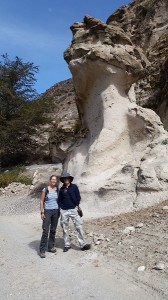 Andata e ritorno in totale 13 km, fatti di passo allegro in 4 ore e mezza per evitare la pioggia del pomeriggio.
Le pitture non ci hanno fatto impazzire, dopo quelle viste a la cueva de las manos in Argentina a Perito Moreno, queste sembrano scarabocchi. Inoltre sono mal tenute e piene di scritte di stupidi vandali, veramente un peccato! Dei locali ci spiegano che il paese e' diviso tra gli allevatori che amano le cose cosi come sono e molto poco i turisti, e gli albergatori con guide turistiche e ristoratori che campano di turismo e vorrebere fare degli investimenti sulle strutture e territorio.
Quindi tra i due litiganti, le pitture rimangono all'aperto e mal conservate.
Il percorso tra rocce, deserto, fiumi, pascoli, lama e coltivazioni a terrazza di alfaalfa ci e' piaciuto molto. Spesso e' il viaggio che conta e non la meta!
Parco Nazionale Lauca: Parinacota, vulcano e citta', lago Chungara', Terme Jurasi. Lunedi 2 Feb.
Andata e ritorno in totale 13 km, fatti di passo allegro in 4 ore e mezza per evitare la pioggia del pomeriggio.
Le pitture non ci hanno fatto impazzire, dopo quelle viste a la cueva de las manos in Argentina a Perito Moreno, queste sembrano scarabocchi. Inoltre sono mal tenute e piene di scritte di stupidi vandali, veramente un peccato! Dei locali ci spiegano che il paese e' diviso tra gli allevatori che amano le cose cosi come sono e molto poco i turisti, e gli albergatori con guide turistiche e ristoratori che campano di turismo e vorrebere fare degli investimenti sulle strutture e territorio.
Quindi tra i due litiganti, le pitture rimangono all'aperto e mal conservate.
Il percorso tra rocce, deserto, fiumi, pascoli, lama e coltivazioni a terrazza di alfaalfa ci e' piaciuto molto. Spesso e' il viaggio che conta e non la meta!
Parco Nazionale Lauca: Parinacota, vulcano e citta', lago Chungara', Terme Jurasi. Lunedi 2 Feb.
 La giornata inizia sempre con una bella mangiata in compagnia di Kerrin, il nostro terzo moschettiere anche lei di buona forchetta. Verso le 9 ci viene a prendere Eugenio un boliviano piccolo e scuro che ci portera' a spasso tutta la giornata. Inizia subito dicendoci che il significato del nome del paesetto di Putre in lingua Aymara e' 'rumore del ruscello'; poi ci pensa e aggiunge che potrebbe essere anche 'muggito della mucca'... perfetto, poche idee ma molto confuse, iniziamo bene!
Ci racconta la storia di Putre che da paese di allevatori e coltivatori, prevalentemente di patate e alfa-alfa, si stia sviluppando con il turismo.
Ci fa vedere anche delle erbe e piante che gli Aymara utilizzavano come medicinali e ci spiega sicuro e orgoglioso tutti i passaggi per la preparazione degli infusi. Ovvio che non ne sappiamo riconoscere nemmeno una e figuriamoci il loro utilizzo. Ricordo solo due nomi 'tola' che e' verde verde e, bevuta in tisana, fa bene alla vescica, mentre 'paja' che e' gialla e secca fa bene agli occhi come un collirio.
La giornata inizia sempre con una bella mangiata in compagnia di Kerrin, il nostro terzo moschettiere anche lei di buona forchetta. Verso le 9 ci viene a prendere Eugenio un boliviano piccolo e scuro che ci portera' a spasso tutta la giornata. Inizia subito dicendoci che il significato del nome del paesetto di Putre in lingua Aymara e' 'rumore del ruscello'; poi ci pensa e aggiunge che potrebbe essere anche 'muggito della mucca'... perfetto, poche idee ma molto confuse, iniziamo bene!
Ci racconta la storia di Putre che da paese di allevatori e coltivatori, prevalentemente di patate e alfa-alfa, si stia sviluppando con il turismo.
Ci fa vedere anche delle erbe e piante che gli Aymara utilizzavano come medicinali e ci spiega sicuro e orgoglioso tutti i passaggi per la preparazione degli infusi. Ovvio che non ne sappiamo riconoscere nemmeno una e figuriamoci il loro utilizzo. Ricordo solo due nomi 'tola' che e' verde verde e, bevuta in tisana, fa bene alla vescica, mentre 'paja' che e' gialla e secca fa bene agli occhi come un collirio.
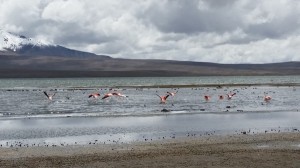 Deliziati da tutta questa cultura locale inizio a fare domande, tipo: "che differenza c'e' tra la lingua Quechua e Aymara?" La mia confusione viene dal fatto che le due popolazioni, a mio parere, molto simili abbiano abitato sugli stessi altopiani ma sviluppando due codici linguistici diversi. Allora Eugenio mi spiega che il Quechua era parlato dagli Inka mentre l'Aymara dalle altre popolzioni piu antiche che popolavano gli altipiani. Inoltre tanto simili non erano, in quanto gli Inka erano un popolo di cacciatori e guerrieri mentre i secondi decisamente piu pacifici. Alcune somiglianze ci sono nelle credenze: entrambi credevano alla Madre Tierra (Pachamama), alla luna (Paucimama) a al sole (Tantainti).
Deliziati da tutta questa cultura locale inizio a fare domande, tipo: "che differenza c'e' tra la lingua Quechua e Aymara?" La mia confusione viene dal fatto che le due popolazioni, a mio parere, molto simili abbiano abitato sugli stessi altopiani ma sviluppando due codici linguistici diversi. Allora Eugenio mi spiega che il Quechua era parlato dagli Inka mentre l'Aymara dalle altre popolzioni piu antiche che popolavano gli altipiani. Inoltre tanto simili non erano, in quanto gli Inka erano un popolo di cacciatori e guerrieri mentre i secondi decisamente piu pacifici. Alcune somiglianze ci sono nelle credenze: entrambi credevano alla Madre Tierra (Pachamama), alla luna (Paucimama) a al sole (Tantainti).
 A Putre ci sono persone che parlano entrambe le lingue come le quattro signore che troviamo sul muretto della piazza. Abbiamo provato ma non volevano farsi capire, gli e' tornato lo spagnolo quando dopo la foto hanno chiesto dei soldi a Pietro. Che dritte eh?
Prima fermata las cuevas, dove ci sono dei ripari naturali usati dagli Aymara per ripararsi mentre attraversavano le montagne. Poi Laguna Chungara' che e' la piu' alta laguna vulcanica al mondo con i suoi 4.500m. Proseguiamo verso la Laguna Cotacotani molto suggestiva nei colori del verde dell'erba, blu celeste dell'acqua e griggio dei vulcani intorno, rispettivamente il Parinacota (6.340m) e il Pomerape (6.280m).
Sulla strada vediamo tutti e quattro i tipi di cammelli: quasti si dividono in due gruppi selvatici e domestici. I primi sono i guanaco e vicuna, mentre gli alpaca e llama appartengono al secondo.
A Putre ci sono persone che parlano entrambe le lingue come le quattro signore che troviamo sul muretto della piazza. Abbiamo provato ma non volevano farsi capire, gli e' tornato lo spagnolo quando dopo la foto hanno chiesto dei soldi a Pietro. Che dritte eh?
Prima fermata las cuevas, dove ci sono dei ripari naturali usati dagli Aymara per ripararsi mentre attraversavano le montagne. Poi Laguna Chungara' che e' la piu' alta laguna vulcanica al mondo con i suoi 4.500m. Proseguiamo verso la Laguna Cotacotani molto suggestiva nei colori del verde dell'erba, blu celeste dell'acqua e griggio dei vulcani intorno, rispettivamente il Parinacota (6.340m) e il Pomerape (6.280m).
Sulla strada vediamo tutti e quattro i tipi di cammelli: quasti si dividono in due gruppi selvatici e domestici. I primi sono i guanaco e vicuna, mentre gli alpaca e llama appartengono al secondo.
 Raggiungiamo per pranzo il paesetto di Parinacota, dove troviamo un baby llama di 6 giorni a cui non ho saputo resistere: si chiamava Stella ed era una specie di pecorella morbidosa e molto affamata. Qui un gran senso di colpa perche' per pranzo mangiamo una zuppa calda buonissima e come secondo un piatto di riso, insalata e fettina di lama.
Sulla strada di ritorno ci fermiamo come ultima tappa alle terme di Jurasi, dove c'e' acqua calda naturale. Nulla di che, praticamente una pozza ma dopo piu di 24 ore senza acqua le terme sono state molto ma molto apprezate!
Domani si riscende a valle ad Arica, tornando alla civilta'.
Raggiungiamo per pranzo il paesetto di Parinacota, dove troviamo un baby llama di 6 giorni a cui non ho saputo resistere: si chiamava Stella ed era una specie di pecorella morbidosa e molto affamata. Qui un gran senso di colpa perche' per pranzo mangiamo una zuppa calda buonissima e come secondo un piatto di riso, insalata e fettina di lama.
Sulla strada di ritorno ci fermiamo come ultima tappa alle terme di Jurasi, dove c'e' acqua calda naturale. Nulla di che, praticamente una pozza ma dopo piu di 24 ore senza acqua le terme sono state molto ma molto apprezate!
Domani si riscende a valle ad Arica, tornando alla civilta'.
Putre
 We decided to go to Putre which is located inland near Arica, pretty much near the border with Bolivia. We wanted to see the volcanoes Pomerape and Parinacota, plus the Lake Chungara all over the 4.000m of height.
Putre is at 3,500m and it is a perfect place to acclimatise to the altitude.
Arica is not far, only 3-4 hours by bus.. well I rather should say diligence, but let's start from the beginning: the alarm clock.
After a sleepless night for myself (I had an acute veggies' attack and I travelled back and forth to the bathroom all night), the alarm instead of ringing at 5.40am - to have time to close the backpacks, to have breakfast and to take a taxi to go to the bus stop, it rang at 6.40am. Oops mistake!
So no breakfast and in net 10 minutes we closed the bags, took the taxi and drove to the bus 'La Paloma', which leaves at 7am every morning to go to Putre, and this is the only way to go. The Paloma is an old fashion bus, only the chickens on the roof were missing!!
We decided to go to Putre which is located inland near Arica, pretty much near the border with Bolivia. We wanted to see the volcanoes Pomerape and Parinacota, plus the Lake Chungara all over the 4.000m of height.
Putre is at 3,500m and it is a perfect place to acclimatise to the altitude.
Arica is not far, only 3-4 hours by bus.. well I rather should say diligence, but let's start from the beginning: the alarm clock.
After a sleepless night for myself (I had an acute veggies' attack and I travelled back and forth to the bathroom all night), the alarm instead of ringing at 5.40am - to have time to close the backpacks, to have breakfast and to take a taxi to go to the bus stop, it rang at 6.40am. Oops mistake!
So no breakfast and in net 10 minutes we closed the bags, took the taxi and drove to the bus 'La Paloma', which leaves at 7am every morning to go to Putre, and this is the only way to go. The Paloma is an old fashion bus, only the chickens on the roof were missing!!
 In Putre there is nothing, and since it's the rainy season it rains every afternoon. The natural consequence is that services are not always available, so there was no water and electricity. We did not give up and we went to leave the backpacks to the hostel. We booked two beds in the dormitory, in the Chakana, a hostel just outside the center that has little houses of two, three, four or six beds for guests with bathroom. It was cute, if it were not for the locals who run it: they were sociable as cactus. Considering the communication issues, we managed to extract information for hiking and a beautiful little map with tactics captions.
We went out for a ride with Kerrin's company, a German travelling for six months in South America. She was with us at the hostel in Arica, in the bus, and now she became part of our small group. In a short time we got organised for Monday going to the volcanoes, the lake and the hot springs, plus we decided to take a walk the next day to see the paintings of Wilacabrani cave.
Pictografías de Wilacabranu. Sunday, February 1st.
In Putre there is nothing, and since it's the rainy season it rains every afternoon. The natural consequence is that services are not always available, so there was no water and electricity. We did not give up and we went to leave the backpacks to the hostel. We booked two beds in the dormitory, in the Chakana, a hostel just outside the center that has little houses of two, three, four or six beds for guests with bathroom. It was cute, if it were not for the locals who run it: they were sociable as cactus. Considering the communication issues, we managed to extract information for hiking and a beautiful little map with tactics captions.
We went out for a ride with Kerrin's company, a German travelling for six months in South America. She was with us at the hostel in Arica, in the bus, and now she became part of our small group. In a short time we got organised for Monday going to the volcanoes, the lake and the hot springs, plus we decided to take a walk the next day to see the paintings of Wilacabrani cave.
Pictografías de Wilacabranu. Sunday, February 1st.
 After a hearty breakfast with the cumbre music, courtesy of the cactus family, we began our trek to the paintings of 'wila' (red) 'cabrani' (Lama) according to the Aymara language, the population living and that lived on altipiano of Chile, Peru and Bolivia.
Return trip was a total of 13 km, done in 4 and a half hours to avoid the rain in the afternoon.
We didn't go crazy for the paintings after those seen in the Cueva de las Manos in Argentina; these in comparison seemed scribbles. Also they were badly maintained and had full of writings of stupid vandals. Really a shame! Some locals explained that the village is divided between breeders, who prefer things as they are without tourist, and tour guides, hoteliers and restaurateurs who would like to increase the tourism and invest on structures and territory.
So between the two fighters, the paintings remain open and poorly preserved.
We loved the path between the rocks, desert, rivers, pastures, terraced fields of alfalfa. Often it is the journey that matters, not the destination!
Lauca National Park: Parinacota, volcano and city, Chungara' lake, Jurasi hot springs. Monday 2 Feb.
After a hearty breakfast with the cumbre music, courtesy of the cactus family, we began our trek to the paintings of 'wila' (red) 'cabrani' (Lama) according to the Aymara language, the population living and that lived on altipiano of Chile, Peru and Bolivia.
Return trip was a total of 13 km, done in 4 and a half hours to avoid the rain in the afternoon.
We didn't go crazy for the paintings after those seen in the Cueva de las Manos in Argentina; these in comparison seemed scribbles. Also they were badly maintained and had full of writings of stupid vandals. Really a shame! Some locals explained that the village is divided between breeders, who prefer things as they are without tourist, and tour guides, hoteliers and restaurateurs who would like to increase the tourism and invest on structures and territory.
So between the two fighters, the paintings remain open and poorly preserved.
We loved the path between the rocks, desert, rivers, pastures, terraced fields of alfalfa. Often it is the journey that matters, not the destination!
Lauca National Park: Parinacota, volcano and city, Chungara' lake, Jurasi hot springs. Monday 2 Feb.
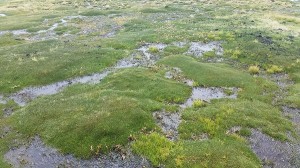 The day starts with a good meal with the good company of Kerrin, our third musketeer who loves eating like us. At about 9am Eugenio came to pick us up; he is a small and dark Bolivian that took us around all day.
He started straight away telling us the meaning of the name of the little village of Putre in Aymara, this is 'sound of the river'. Then he thought a bit more and added that it could also be 'the mooing of the cow'... perfect! Few ideas and very confused, good start!
He continued telling the history of Putre that from a country of farmers and growers, mainly potatoes and alfalfa, it is developing with tourism.
He made us to see even the herbs and plants used as medicines by the Aymaras and explained, sure and proud, all the steps for the preparation of infusions. Obviously we do not know and recognise even one of them and their usage. I only remember two names: 'tola' which is really green, drunk in tea, and good for the bladder; and 'paja' which is yellow and dry, good for the eyes as eye drops.
The day starts with a good meal with the good company of Kerrin, our third musketeer who loves eating like us. At about 9am Eugenio came to pick us up; he is a small and dark Bolivian that took us around all day.
He started straight away telling us the meaning of the name of the little village of Putre in Aymara, this is 'sound of the river'. Then he thought a bit more and added that it could also be 'the mooing of the cow'... perfect! Few ideas and very confused, good start!
He continued telling the history of Putre that from a country of farmers and growers, mainly potatoes and alfalfa, it is developing with tourism.
He made us to see even the herbs and plants used as medicines by the Aymaras and explained, sure and proud, all the steps for the preparation of infusions. Obviously we do not know and recognise even one of them and their usage. I only remember two names: 'tola' which is really green, drunk in tea, and good for the bladder; and 'paja' which is yellow and dry, good for the eyes as eye drops.
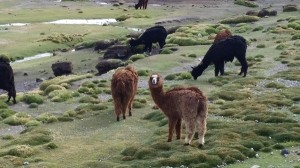 Delighted by all this local culture, I begun to ask questions, like: "which is the difference between the Quechua and Aymara?"
My confusion came from the fact that the two populations, in my opinion, are much alike as they have lived in the same altipiano, but developed two different linguistic codes. Then Eugenio explained that the Quechua was spoken by the Inka and the Aymara from older populations who populated the highlands. Also they were not so alike as the Inka were hunters and warriors, while the second ones were much more peaceful. There were some similarities in their beliefs: both believed in Mother Earth (Pachamama), the moon (Paucimama) and the sun (Tantainti).
Delighted by all this local culture, I begun to ask questions, like: "which is the difference between the Quechua and Aymara?"
My confusion came from the fact that the two populations, in my opinion, are much alike as they have lived in the same altipiano, but developed two different linguistic codes. Then Eugenio explained that the Quechua was spoken by the Inka and the Aymara from older populations who populated the highlands. Also they were not so alike as the Inka were hunters and warriors, while the second ones were much more peaceful. There were some similarities in their beliefs: both believed in Mother Earth (Pachamama), the moon (Paucimama) and the sun (Tantainti).
 In Putre there are people who speak both languages as the four ladies we found sitting on the wall of the square. We tried to communicate with them but they did not want to be understood, and they switched back to Spanish after Pietro took a photo, asking for money. Cleaver eh?
First stop las cuevas, where there were natural shelters used by the Aymara when they crossed the mountains. Then Laguna Chungara which is the most high volcanic lagoon in the world with its 4.500m. We continued towards the Laguna Cotacotani which was very impressive with the colours: green of grass, blue-light blue of the water and grey of the volcanoes around, respectively Parinacota (6.340m) and the Pomerape (6.280m).
On the way, we saw all four types of camels, these are divided into two groups: wild and domestic. The first are the guanaco and vicuna, while the second one are the alpaca and llama.
In Putre there are people who speak both languages as the four ladies we found sitting on the wall of the square. We tried to communicate with them but they did not want to be understood, and they switched back to Spanish after Pietro took a photo, asking for money. Cleaver eh?
First stop las cuevas, where there were natural shelters used by the Aymara when they crossed the mountains. Then Laguna Chungara which is the most high volcanic lagoon in the world with its 4.500m. We continued towards the Laguna Cotacotani which was very impressive with the colours: green of grass, blue-light blue of the water and grey of the volcanoes around, respectively Parinacota (6.340m) and the Pomerape (6.280m).
On the way, we saw all four types of camels, these are divided into two groups: wild and domestic. The first are the guanaco and vicuna, while the second one are the alpaca and llama.
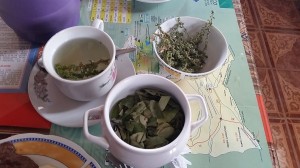 We reached for lunch the little village of Parinacota, where we find a baby llama of 6 days, and I could not resist to cuddle: she was called Star and was a sort of sheep really cuddlable and hungry. Here it comes a great sense of guilt because for lunch we had a hot and delicious soup and as a main a plate of rice, salad and llama steak.
On the way back we stopped as our last stop at the hot spring of Jurasi, where there is natural hot water. Not really impressive, pretty much a little pool but after more than 24 hours without water, the hot bath has been very, very appreciated!
The following day we went back down to the valley, back to Arica, and back to civilisation.
We reached for lunch the little village of Parinacota, where we find a baby llama of 6 days, and I could not resist to cuddle: she was called Star and was a sort of sheep really cuddlable and hungry. Here it comes a great sense of guilt because for lunch we had a hot and delicious soup and as a main a plate of rice, salad and llama steak.
On the way back we stopped as our last stop at the hot spring of Jurasi, where there is natural hot water. Not really impressive, pretty much a little pool but after more than 24 hours without water, the hot bath has been very, very appreciated!
The following day we went back down to the valley, back to Arica, and back to civilisation. 